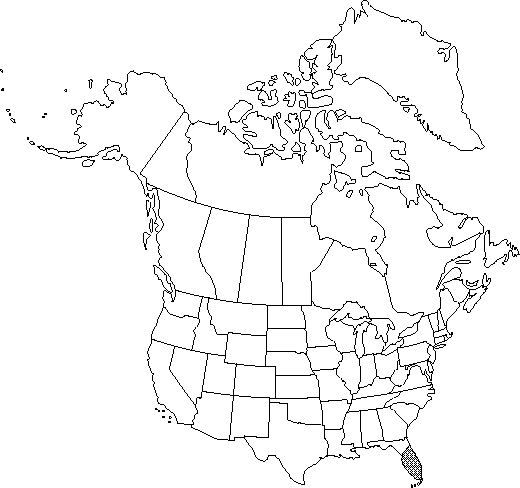Difference between revisions of "Asimina reticulata"
Fl. South. U.S. ed. 2, 603. 1883.
FNA>Volume Importer |
FNA>Volume Importer |
(No difference)
| |
Revision as of 22:14, 16 December 2019
Shrubs, to 1.5 m; crown much branched. Shoots red-brown to tan, distally red or pale-hairy, becoming gray-brown, distally glabrous or sparsely pale-hairy. Leaves: petiole 2-6 mm. Leaf blade oblong to elliptic or narrowly obovate, 5-8 cm, leathery, base abruptly and broadly cuneate or rounded, margins strongly to moderately revolute, apex acute to broadly rounded, occasionally notched; surfaces abaxially densely orange-hairy, becoming sparsely so on veins, adaxially sparsely orange-hairy, becoming glabrous and often glaucous. Inflorescences on previous year's growth; peduncle slender, 2-3.5 cm, tomentose; bracteoles 1-2, basal, usually ovate-triangular, rarely more than 2-3 mm, hairy. Flowers 1-3 per node, fragrant, large; sepals triangular, 8-10 mm, abaxially orange-puberulent; outer petals spreading, white or cream, narrowly oblong to obovate, 2.5-6 cm, abaxially puberulent on veins; inner petals incurved, white, yellowish white, rarely pink or cherry red, mostly with deep maroon to purple corrugate zone, lance-hastate, 1/3-1/2 length of outer petals, fleshier, base saccate, margins revolute; pistils 3-8. Berries yellow-green, 4-7 cm. Seeds dark to pale brown, lustrous, 1-2 cm. 2n=18.
Phenology: Flowering winter–spring.
Habitat: Moist sands and sandy peat of pine-palmetto flats, savannas, low fields
Elevation: 0-100 m
Discussion
Asimina reticulata hybridizes with A. incana and A. pygmaea. Hybrids with the latter frequently have cherry-red inner petals.
Selected References
None.
